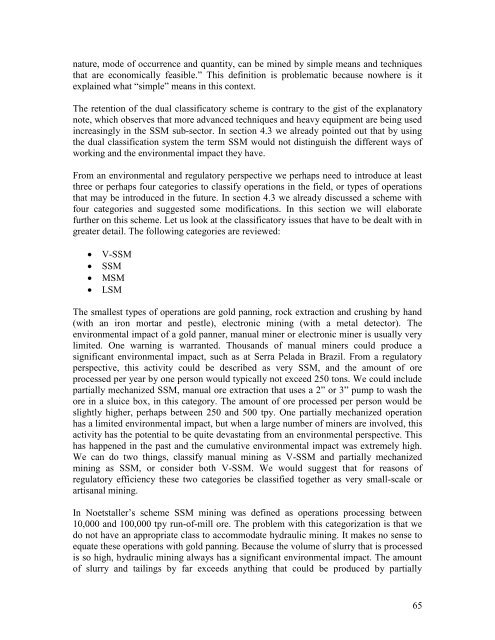SITUATION ANALYSIS OF THE SMALL-SCALE GOLD ... - WWF
SITUATION ANALYSIS OF THE SMALL-SCALE GOLD ... - WWF
SITUATION ANALYSIS OF THE SMALL-SCALE GOLD ... - WWF
Create successful ePaper yourself
Turn your PDF publications into a flip-book with our unique Google optimized e-Paper software.
nature, mode of occurrence and quantity, can be mined by simple means and techniques<br />
that are economically feasible.” This definition is problematic because nowhere is it<br />
explained what “simple” means in this context.<br />
The retention of the dual classificatory scheme is contrary to the gist of the explanatory<br />
note, which observes that more advanced techniques and heavy equipment are being used<br />
increasingly in the SSM sub-sector. In section 4.3 we already pointed out that by using<br />
the dual classification system the term SSM would not distinguish the different ways of<br />
working and the environmental impact they have.<br />
From an environmental and regulatory perspective we perhaps need to introduce at least<br />
three or perhaps four categories to classify operations in the field, or types of operations<br />
that may be introduced in the future. In section 4.3 we already discussed a scheme with<br />
four categories and suggested some modifications. In this section we will elaborate<br />
further on this scheme. Let us look at the classificatory issues that have to be dealt with in<br />
greater detail. The following categories are reviewed:<br />
V-SSM<br />
SSM<br />
MSM<br />
LSM<br />
The smallest types of operations are gold panning, rock extraction and crushing by hand<br />
(with an iron mortar and pestle), electronic mining (with a metal detector). The<br />
environmental impact of a gold panner, manual miner or electronic miner is usually very<br />
limited. One warning is warranted. Thousands of manual miners could produce a<br />
significant environmental impact, such as at Serra Pelada in Brazil. From a regulatory<br />
perspective, this activity could be described as very SSM, and the amount of ore<br />
processed per year by one person would typically not exceed 250 tons. We could include<br />
partially mechanized SSM, manual ore extraction that uses a 2” or 3” pump to wash the<br />
ore in a sluice box, in this category. The amount of ore processed per person would be<br />
slightly higher, perhaps between 250 and 500 tpy. One partially mechanized operation<br />
has a limited environmental impact, but when a large number of miners are involved, this<br />
activity has the potential to be quite devastating from an environmental perspective. This<br />
has happened in the past and the cumulative environmental impact was extremely high.<br />
We can do two things, classify manual mining as V-SSM and partially mechanized<br />
mining as SSM, or consider both V-SSM. We would suggest that for reasons of<br />
regulatory efficiency these two categories be classified together as very small-scale or<br />
artisanal mining.<br />
In Noetstaller‟s scheme SSM mining was defined as operations processing between<br />
10,000 and 100,000 tpy run-of-mill ore. The problem with this categorization is that we<br />
do not have an appropriate class to accommodate hydraulic mining. It makes no sense to<br />
equate these operations with gold panning. Because the volume of slurry that is processed<br />
is so high, hydraulic mining always has a significant environmental impact. The amount<br />
of slurry and tailings by far exceeds anything that could be produced by partially<br />
65
















